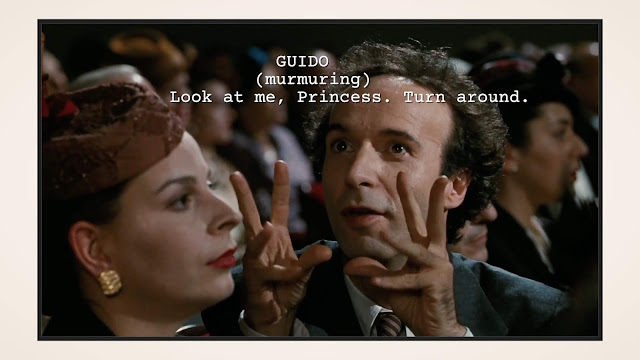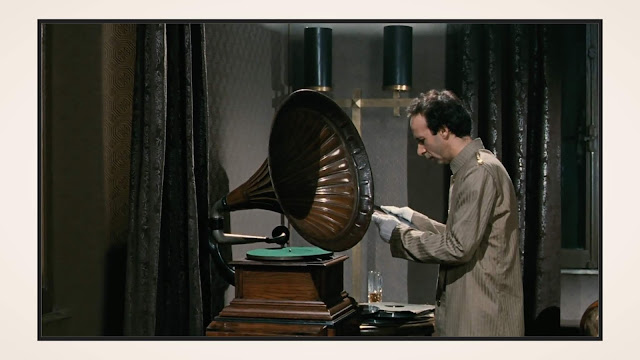Today's guest post is talking ALL about the setup and payoff - two things that as writers and filmmakers, we know can be tricky elements to pull off correctly! However, with Pietro's handy post AND YouTube video - you'll now have a step by step example on how to overcome any struggles with this in the future!
So, let's hand over to Pietro.
So, let's hand over to Pietro.
Roberto Benigni’s Life is beautiful has a special place in my heart. It’s one of the cinematic experiences that brought me to become a screenwriter and always brings tears to my eyes.
The movie has an unconventional structure of two acts instead of three. The act break happens exactly halfway in the movie.
What brings these two parts together is the writers’ ability to use a powerful screenwriting technique: Setup & Payoff.
It consists in planting an element as if it’s natural part of the story, something that doesn’t appear to be relevant. And then, bringing it back and giving it a much deeper meaning. When done well, this has a strong emotional impact with the audience.
Since this is a 1997 movie, let’s start by refreshing our memory with this quick plot summary.
PART ONE:
In act one, we meet Guido, an Italian Jew who falls in love with Dora. In act two, Guido and Dora keep meeting each other by chance and Guido tries to win her heart. At the mid point they have a strange date. In act three, Guido discovers that Dora is getting engaged with an arrogant fascist man and convinces her to escape with him. Years later, they live happy together with their son Joshua.
PART TWO:
The first act starts when Guido and Joshua are captured and brought to a nazi concentration camp. The act break is the iconic scene in which Guido translates the camp rules, making the whole internment sound like a game. The second act is about preserving Joshua’s innocence and life. At the mid point Guido appears to get help from a nazi doctor, but soon realizes that there is no hope. In the third act the war is culminating and Guido manages to save Joshua, before getting killed by the nazis.
Now let’s discover how these two parts are brought together using Setup and Payoff.
Good morning, Princess!
SETUP: Guido makes up a story about being a prince and greets dora with the phrase: “Good morning, Princess!”
PAYOFF: This becomes a recurring phrase that Guido says to Dora every time he sees her, each time acquiring a deeper meaning. Like when Dora fears that her son got killed, but listens to his voice from the camps speakers.
Mary, the key!
SETUP: In the background we see a man asking his wife for the house key and she throws it to him from a window above.
PAYOFF: When Guido and Dora stand right under the lady’s window, Dora tells Guido that only Heaven knows where the key to her heart is. So Guido ask the Virgin Mary for the key (Mary, the key!), the lady throws him the key, which appears to have fallen from Heaven.
Dr. Lesser’s Riddles.
SETUP: Before being captured, Guido befriends a German doctor obsessed with riddles.
PAYOFF: In the concentration camp, Guido and Dr. Lessing recognize each other through a riddle. Guido hopes that the doctor would help him, but realizes that he’s only interested in solving a new riddle. This scene is filled with dramatic irony.
Schopenhauer.
SETUP: Guido’s roommate explains that Schopenhauer used to say that with willpower you can do anything, you just have to repeat to yourself what you want.
PAYOFF 1: Guido uses this technique to make Dora look at him in a crowded theatre.
PAYOFF 2: Using Schopenhauer’s trick, Joshua walks toward his mom, while hiding inside a cabinet.
PAYOFF 3: Guido uses the trick again to send away a dog that was leading the nazis to Joshua’s hiding.
Offenbach.
SETUP: Guido and Dora go to the opera to watch Offenbach. The song Belle Nuit is playing.
PAYOFF: In the concentration camp, Guido plays a record with that song and moves the gramophone toward the window, so that Dora can listen to it.
Guido’s walk.
SETUP: One day, Guido gets forcefully taken for interrogations by fascist officials. Seeing the worried look on Joshua’s face, he starts walking in a funny way, as if enjoying the moment.
PAYOFF: Joshua is hiding from the nazis inside a cabinet and sees his dad doing the same funny walk, while marching to his death.
Not showering.
SETUP: At home, Joshua protests a shower.
PAYOFF: In the concentration camp, elders and children are asked to shower, but are instead killed in the gas chamber. Joshua avoiding a shower saves his life.
The tank.
SETUP: Guido Tells Joshua that the first price for the camp game will be a real tank.
PAYOFF: The American soldier who rescues Joshua, takes him on his real tank, fulfilling his dad’s promise.
Now it’s your turn, take your script and find moments where you can add setup and payoff.
Pietro Schito is an Italian screenwriter, producer. After working in TV Production in Italy, he moved to Hollywood where he completed the New York Film Academy Screenwriting Program at Universal Studios. He continued working in film and TV for Hollywood, Mexico and Italy with multiple script sales and options, shorts films and TV shows produced. Two of his animated feature films are currently in production and he recently started his YouTube Channel about screenwriting. Follow Pietro on social media at @pietroschito and check out his videos on WriteSomethingGreat.com





















I think this is an informative post and it is very useful and knowledgeable. therefore, I would like to thank you for the efforts you have made in writing this article. 123 movies
ReplyDelete